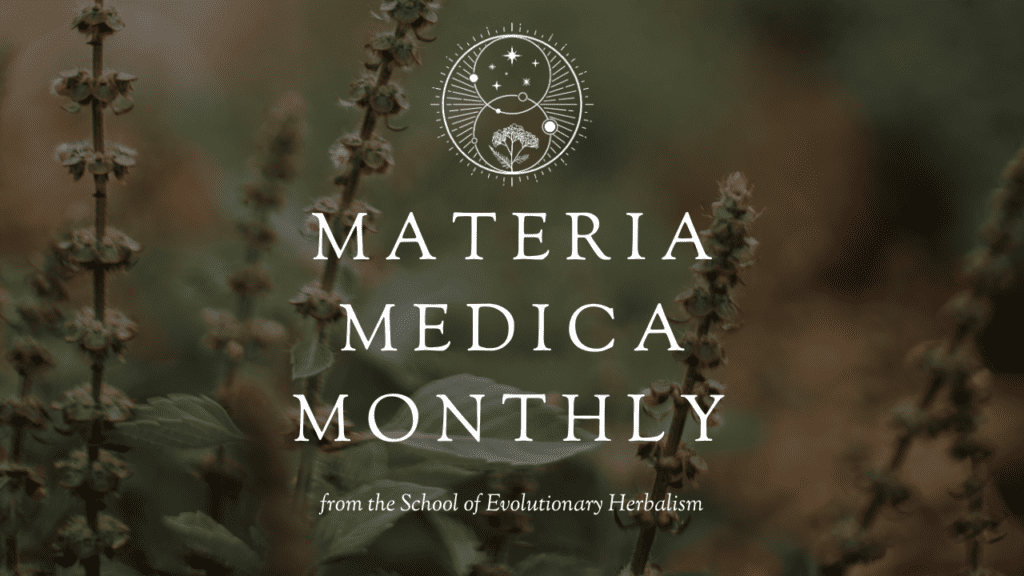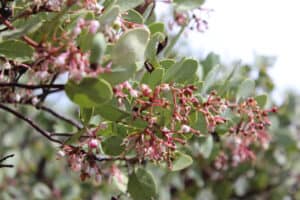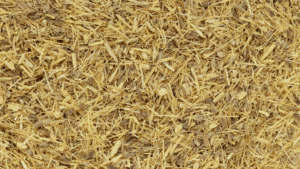Holy basil is a sacred plant in the Indian and Ayurvedic traditions. There is a wide range of conditions for which it is used, both physically and psychologically. Holy Basil is one of nature’s panaceas, making it a powerful plant to grow in your garden and stock in your home.
In today’s plant profile, you’ll discover:
- Holy Basil’s unique taste and how it supports your nervous, digestive, immune system, and more
- Holy Basil’s unique combination of adaptogenic and nervine properties to support the modern stressed condition
- Spiritual applications for this ancient herb
- Its relationship to Jupiter and the Fire Element
- How to prepare medicine with the fresh and dried plant
Table of Contents
Holy Basil, also known as Tulsi, is one of the most sacred plants in the Indian tradition. In Sanskrit, its name translates as “the incomparable one,” alluding to its importance in Ayurvedic medicine and Indian spiritual practice. Holy Basil has a stimulating and uplifting influence on the mind, heart, and body. With its numerous applications and therapeutic uses, it has become a beloved plant integrated in our Materia Medica.
Common name: Tulsi, Holy Basil
Latin name: Ocimum sanctum
Family: Lamiaceae
Tastes: Pungent, aromatic, sweet
Affinities: Digestive, Nervous, Upper Respiratory Tract, Insulin Metabolism, Immune and Febrile Mechanism
Actions: Carminative, Nervine relaxant, Immune Stimulant, Antimicrobial, Stimulant Expectorant, Decongestant, Nootropic, Stimulant and Relaxant Diaphoretic, Adaptogen, Rasayana
Energetics: Warming, Drying, Relaxant
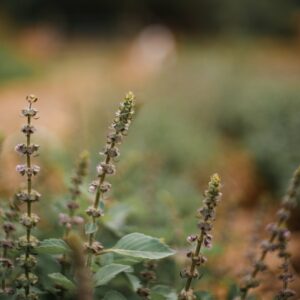
Taste
Holy Basil is in the Mint family. You can easily recognize it by its distinct aromatic and pungent taste, which signifies its high levels of essential oils, along with its opposite leaves and square stems. There is a subtle sweetness beneath these tastes, but I find its pungent flavor most present. The scent and flavor of Holy Basil is quite reminiscent of Cloves, of which it shares some similar constituents, such as eugenol. For most, the flavor of Holy Basil is quite pleasant, which makes it an especially good remedy to consider for tea formulas.
Affinities
Like many other essential oil rich plants, Holy Basil has an affinity for the digestive and nervous systems. It is an excellent remedy for digestive complaints arising from nervousness or anxiety and is similar to Chamomile (Matricaria recutita), Lemon Balm (Melissa officinalis), and Catnip (Nepeta cataria) in that way. For nervous digestion, you can combine Holy Basil with those herbs or take it by itself for its calming, relaxant, and stimulant digestive effects. This combination of influencing the digestive and nervous systems is a highly unique and useful property of Holy Basil that’s very fitting for many modern clients.
These essential oils benefit the upper respiratory tract as well. When you ingest an aromatic plant, the essential oils volatilize upwards and outwards. As you inhale, you receive a direct topical action on the respiratory tissues. Holy Basil radiates its volatile benefits to the sinuses, nose, throat, and even down into the bronchioles a little bit.
Less of an organ affinity and more of a biochemical effect, Holy Basil is scientifically proven to benefit the insulin receptors on the cells by increasing insulin sensitivity. Insulin is a hormone secreted by the pancreas. When you eat starchy foods or sugars, your blood sugar levels rise, and in response the pancreas secretes insulin to bind to the cell receptor so that the sugar can move from the blood and into the cell for energy. As a result, your blood sugar levels lower and stabilize.
In the case of insulin resistance, the blood sugar-binding site on the cell receptor becomes resistant to insulin, meaning that when it binds the doorway to the cell doesn’t open and sugar is unable to enter. This can occur when blood sugar has been consistently high for a long time. When your blood sugar remains high, it can lead to type two diabetes. Holy Basil resensitizes those cellular receptors to insulin so that blood sugar levels can lower. This is a fairly unique herbal property, shared by herbs Devil’s Club (Oplopanax horridus) and Goat’s Rue (Galega officinalis).
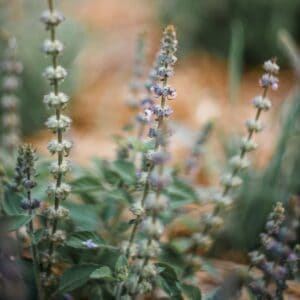
Actions
Holy Basil’s action in the digestive system is as a carminative. It brings blood flow to the digestive system and alleviates gas, bloating, distention, and minor digestive complaints. It does exhibit a minor spasmolytic property and can help relax tension in the gut, as well as generally stimulating digestive secretions as a carminative.
Within the nervous system, Holy Basil gently calms and relaxes the mind through its nervine sedative property. At the same time, it has an uplifting effect that imbues a sense of peaceful happiness. Although there is no herbal action named for this that I know of, I describe it as a nervine uplifter. It could be considered nootropic in this way, which means it helps to clarify the mind and senses, enhancing cognitive function. This is achieved through increasing cerebral circulation, but in combination with a nervine effect makes it very well suited for cognitive function. Indeed in traditional Indian medicine it has been used to counter the ill effects of excessive Cannabis smoking. Calming and uplifting, Holy Basil is a wonderful herb if you experience anxiety and depression. One of the nice things about it is that you can drink it throughout the day for a relaxing pick-me-up and it will not make you drowsy. This is a unique property, in that it is calming and uplifting at the same time.
Holy Basil modulates activity in the immune system. Combined with its affinity for the respiratory tract, you have an excellent remedy for respiratory tract infections, sinus conditions, and fever. Its pungency and stimulant expectorant action clears stagnated mucus from the sinuses, throat, and upper bronchial tract. It also protects these areas with its antimicrobial property. On top of that, Holy Basil is also a diaphoretic and stimulates a sweat in the case of fever. With its antiseptic, expectorant, and decongestant properties, it has significant immunological activity. As a relaxant and stimulant diaphoretic, Holy Basil promotes sweating when you have a tense fever that you can’t seem to break. By relaxing the vasculature and increasing circulation, it moves core heat out and through the pores. This is a superb combination of actions for supporting a variety of respiratory tract infections, colds, flus, fevers, etc.
Aside from its ability to clear a head cold, Holy Basil clears the mind and enhances cognitive functioning with its nootropic action. Nootropics are typically circulatory stimulants with an affinity for the brain and head. Holy Basil improves blood flow to the entire area, thereby improving focus, memory recall, and concentration. Some nootropics, like this plant, affect the nervous system as well.
Finally, one of Holy Basil’s most popular associations is as an adaptogen. Adaptogens help your body cope with and adapt to stress, typically by acting on the hypothalamic-pituitary-adrenal axis, other attributes of the endocrine system, and/or the nervous system. Holy Basil’s adaptogenic property is based on its influence on the nervous and endocrine systems and helping the body adapt to various stressors, such as overstimulation and oxidative stress. By improving your stress response, you develop a more even-keel disposition that does not get dysregulated by stress as easily. By clearing the mind and uplifting the spirit. Holy Basil helps you develop healthier ways to cope with and respond to stress. Holy Basil’s adaptogenic property connects with its property as a rasayana, which according to Ayurveda, helps to rejuvenate and revitalize a depleted, worn, and burned-out person (rasayana is essentially a rejuvenative tonic herb). Along these same lines, Holy Basil has been shown to exhibit pretty remarkable antioxidant protection throughout the body, but most notably in the liver.
Of course, taking an adaptogen does not replace good sleep, a healthy diet, nutritional supplementation, and therapeutic help. However, you can use it as a part of a larger plan to support you in your healing process.
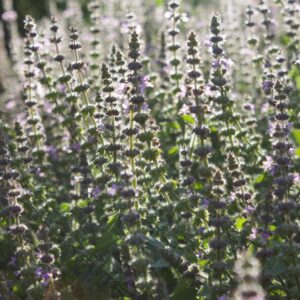
Energetics
Holy Basil is pungent, warming, and drying. Interestingly enough, the seeds are demulcent and used as a moistening agent for irritable urinary tract conditions. However, you typically use the leaves of Holy Basil to prepare medicine, and they are drying since they have diaphoretic and mild diuretic properties, not to mention its relatively warming which often leads to dryness. Lastly, Holy Basil is a relaxant. You can see this tonal quality in its significant nervine properties.
In the Ayurvedic tradition, Holy Basil balances an excess of vata (as a warming relaxant) and kapha (as a warming, drying uplifting agent). It has the potential for aggravating pitta due to its pungent and warming nature.
Holy Basil is indicated for the wind/tension, cold/depression, and damp/stagnation tissue states. Its nervine and carminative actions relax tension and stress in the mind and constriction, gas, bloating (IE wind) in the digestive system. Its stimulant expectorant action warms up cold lungs, and its drying anticatarrhal (phlegm reducing) restores balance to damp/stagnation. It can also relax wind/tension in the respiratory tract, making it have some applications towards asthmatic conditions.
Psychological and Emotional Aspects
When I think about anxiety, I typically break it down into two categories. In the first group, you have someone with an excess of vata. They’re scattered, ungrounded, and kind of all over the place. This is a more deficient type, where they often aren’t well-nourished and anchored in their body. This constitutional pattern requires herbs that calm, ground, and settle the spirit. Holy Basil uplifts the spirit and has an energetic dynamic that moves upward and out–all of which can be a bit ungrounding for vata. Some people take Tulsi and feel perhaps less anxious because they’re calm, but they also start to space out a little more which isn’t always very conducive to cognitive function. It can certainly be used in these cases, but I typically prefer to formulate it with some other remedies that will be a bit more grounding and nourishing, such as Skullcap (Scutellaria lateriflora), Milky Oats (Avena sativa), or Passionflower (Passiflora incarnata), the latter of which is very good for the spaced out, excessive mental energy type person.
The second type is characterized by a pattern of excess kapha, or cold dampness in the mind, with symptoms of brain fog, heaviness, and mental and emotional lethargy. This is the pattern I tend to prefer to use Holy Basil. If you feel like you are thinking through cotton balls, Holy Basil is a good herb for you. People with the kapha dosha tend to feel weighed down. With its upward energy, Holy Basil is the perfect herb for dispersing this weight and clearing the mind. For these folks I like to combine it with Lemon Balm (Melissa officinalis), Bacopa (Bacopa monnieri), Gotu Kola (Centella asiatica), or Rosemary (Rosmarinus officinalis).
This points towards its common modern usage for treating certain types of depression. According to the herbalist David Winston in his book Adaptogens, “I also use holy basil as an antidepressant for “stagnant depression.” The term stagnant depression is one that I coined, and it describes a specific type of situational depression. In this case, some type of traumatic event occurred in a person’s life, and because he is unable to move on, his life comes to revolve around the trauma. In addition to therapy, herbs such as holy basil, damiana, rosemary, and lavender are especially useful for treating this condition.”
To me this is an inherently psychological, emotional and even spiritual property of this plant, for trauma touches the deepest parts of the self, what in alchemy would be considered the soul or our inner Sulfur. A plant that can help us resolve these deep life challenges is certainly one worth getting to know and acquainted with, as we all have some sort of wound on our hearts or traumas that we’ve gone through can use some healing.
Another traditional use of Holy Basil psychologically is as an antidote for people who excessively use Cannabis. Cannabis abuse can lead to either of the psychological patterns above: either a melancholic malaise or a flighty, ungrounded, anxious disposition. I’ve found this usually depends on ones predisposition and constitution. With its circulatory and pungent nootropic action, Holy Basil uplifts the spirit, sharpens the mind, and clears your head so that you can think and feel better.
In India, Holy Basil is considered one of the most sacred plants, used to promote longevity and perfect one’s health, as well as spiritual practice. It is said to possess the pure energy of sattva, or promoting overall balance and purity, as well as cleansing and maintaining the balance of the chakras. In a way, everything about this plant is considered spiritual and holy, and in that way it’s said to feed the holy within us and thus strengthens the spiritual side of our lives. Though to me, this isn’t a passive thing, but rather requires us to “meet the herb halfway” and consciously connect with it on this level. In this way though, I’ve used it to help people reconnect to their spiritual life, to be reinspired by a spiritual practice like meditation, chi gong or prayer, or for people that feel distanced from that part of themselves from over identification with the more mundane aspects of life. To me I feel like it helps us to not create a boundary between “this is spiritual and this is not,” but helps us to see how everything is spiritual, we need only learn to cultivate the perception to see life as such. That it’s all around us, all the time, we just have to learn to see it.
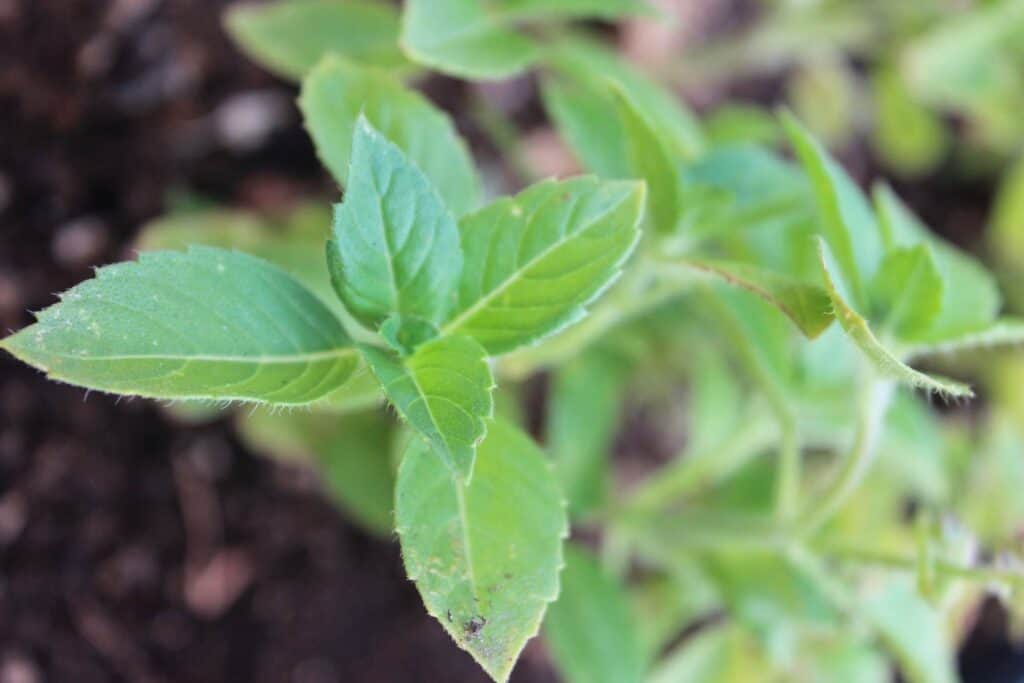
Alchemical Correspondences
Holy Basil is a highly revered plant in the Indian tradition. In fact, it is considered one of their most sacred herbs. It has a rich history of usage for physical and spiritual applications. This herb has a distinctly uplifting energy and when you drink Holy Basil tea, you feel happy and light in the heart and mind. These qualities are a great representative of a plant ruled by Jupiter. This planet is associated with faith, belief, and devotion to a higher purpose. Jupiter is a gas planet and herbs ruled by this planet, like Holy Basil, tend to have an upwards and outwards quality to them both in how they affect us physiologically (like a circulatory stimulant diaphoretic) as well as more esoterically, helping to expand your consciousness beyond the self.
Jupiter is considered the “greater benefic,” bestowing upon us a blessing as well as a protection from harm. This is to me precisely what Holy Basil does: it uplifts and calms us, it blesses us with a spiritual orientation in the mind, and it clearly protects us physically in a myriad of ways with its antioxidant, antimicrobial, expectorant, diaphoretic, nervine, and adaptogenic properties. It is interesting to note that the antioxidant protection is highest in the liver, and Jupiter is the governing planet of the liver. In short, the feeling of Jupiter is happiness, and in my opinion Holy Basil clearly supports us in that most noble pursuit. This is likely why it’s so effective at treating certain types of depression.
This plant has a longstanding usage in meditation and in assisting yogis with their focus. Holy Basil is likely helpful here because of its nootropic action, which improves mental focus and clarity of the mind and heart. While Holy Basil is gently relaxing, it will not make you drowsy–the perfect herb for meditation. Again, helping to instill faith and belief in something greater than the self is an inherently Jupiter concept.
I associate Holy Basil with the Fire Element. You can spot some classic Fire signs with its serrated leaf margins, pungent taste, and stimulating, circulatory, expectorant, and diaphoretic properties. Ultimately, Holy Basil stimulates a lot of attributes in the body, which is a core trait of the Fire Element. It clears cold and damp phlegm both from the respiratory tract and from the mind, something also commonly associated with metabolic syndrome and insulin resistance as well.

Growing Holy Basil
Holy Basil shares many botanical traits with other plants in the Mint family. It has square stems, opposite leaves, and is deeply aromatic. Holy Basil is native to India and has naturalized in different parts of Asia. This plant prefers warm weather and does not fare too well with frost. Here in the Pacific Northwest, we start our Holy Basil plants by seed and plant them inside the greenhouse. After the final frost has passed, we move them outside. Afterwards they’re pretty easy and just do their thing like many other mints.
The best time to pick the aerial parts is when it has just begun to flower but has not set seed. This is a short window of time, so keep an eye out for this! Because it is an annual, Holy Basil will die back in the fall. You can collect the seeds during that time and save them to plant in your greenhouse in the following spring. They oftentimes spread around the garden pretty easily as well by self seeding.

Preparation
Holy Basil is a pleasant herb to prepare and ingest because it tastes so good. Because it’s an aromatic plant, I prefer to use it fresh. However, you can certainly prepare a plant medicine with dried leaves, and it will not significantly lose its aromatic properties if you dry it relatively slowly and carefully in the shade.
To prepare an infusion, combine 1-3 teaspoons of the dried herb with 1 cup of water. Cover and steep the tea for 15-30 minutes, and drink 2-3 cups a day. Start low and increase your dosage until you find what strength infusion works best for you.
For a fresh leaf and flower tincture, use a ratio of 1:2, with around 75% alcohol, which captures the volatile oils very nicely. For a tincture made with the dried leaf and flower, use a ratio of 1:5 at 50% alcohol. The standard tincture dosage is 30-60 drops three times a day. As always, you can start with less and work your way up to find your ideal dosage range.
If there were only ten herbs you could grow and have in your home apothecary, Holy Basil is one of the ones I would suggest. I encourage you to get to know this plant because of its versatility and ability to support a variety of organ systems, tissue states, and conditions. A panacea unto itself, Holy Basil is a prized remedy with an ancient past and a bright future in our modern Materia Medica.
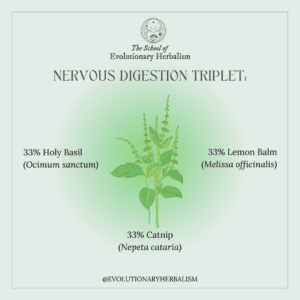
Nervous Digestion Triplet
33% Lemon Balm (Melissa officinalis)
33% Catnip (Nepeta cataria)
33% Holy Basil (Ocimum sanctum)
This simple triplet includes three carminative nervines and has a net warming influence. This formula is ideal for cold, vata constitutions with tension and can be enjoyed as a tasty infusion or tincture. This is a great simple, gentle formula to keep you calm and relaxed throughout the day without making you overly drowsy. It also gently warms and stimulates digestion, relieves gas, bloating, and other minor digestive upsets. And it tastes great!
Get a Free Holy Basil Monograph
If you enjoyed this plant profile then I know you would love the Holy Basil issue of Materia Medica Monthly where I go into even more detail on the Five Keys, Clinical Patterns, Therapeutics & Administration, as well as Formulation Strategies, Planetary, Elemental, and Philosophical Principle correspondence, Esoteric and Spiritual Virtues, and more.
Click the button below to get your free issue of Materia Medica Monthly:


